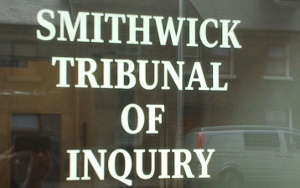
Testimoniando settimana scorsa in aula, Myers ha detto di aver scritto un articolo nel marzo 2000 nel quale evidenziava la presunta collusione della Garda con il gruppo di fuoco dell’IRA, ritenendo che almeno 12 uccisioni erano state compiute grazie all’aiuto di una sola talpa IRA che operava nella stazione di polizia.
Le sue fonti principali per la rubrica – pubblicato nella serie “Irishman’s Diary” sull’Irish Times – erano un ex poliziotto ed un “terrorista”. Aveva basato alcune delle sue comprensioni degli eventi sul libro dell’ex giornalista del Daily Telegraph Toby Harnden, Bandit Country.
Ha spiegato in tribunale che secondo lui entrambe le fonti parlavano della stessa talpa, ma in seguito ha scoperto che si riferivano a due diversi membri della Garda, i cui cognomi iniziano entrambi con la lettera C. Questo era l’errore riportato nell’articolo.
Myers ha riferito al giudice Peter Smithwick che la sua fonte nella polizia si riferiva a “Colton” – ovvero il sergente Leo Colton, ora in pensione, che lavorava nella stazione di polizia di Dundalk negli anni Ottanta. Anche la fonte del gruppo armato parlava di un uomo il cui cognome iniziava con la C, ma in seguito aveva scoperto che si trattava del sergente Owen Corrigan, anch’egli in forze nella stazione Garda di Dundalk.
Adesso è convinto della presenza di almeno due agenti della Garda all’opera per conto dell’IRA a Dundalk, e forse anche un’intera cellula. Nel contro interrogatorio eseguito dall’avvocato Jim O’Callaghan, per Owen Corrigan, Myers ha affermato che “cellula suggerisce una coerenza che poteva non esistere”. Il giornalista ha spiegato di sapere poco di Corrigan e di non aver fatto il suo nome nell’articolo, ma sono stati altri a farlo trapelare. “Era una rivelazione scioccante da fare”, ha detto Myers, “ma non sono stato io”.
Ha riconosciuto di aver sbagliato su alcuni dettagli in relazione ad alcuni degli omicidi, spiegando a O’Callaghan come l’articolo fosse basato sulle sue opinioni e affermazioni. Una rubrica, infatti, ha “un diverso svolgersi fattuale” rispetto ad un articolo o ad un commento editoriale. “Tutto quello che possiamo fare è dire la verità nella maniera più sincera ed imparziale possibile”, ha proseguito.
O’Callaghan ha chiesto: “Pensi che l’articolo dicesse la verità in una maniera giusta ed imparziale?”. La risposta laconica di Myers è stata: “No, non credo”, spiegando di aver scritto il pezzo perché “c’erano troppo operazioni di confine andate male senza qualcosa sistematicamente sbagliato”.
Tratto da The Irish Times
Myers believed at least two IRA moles in Garda station
Giving evidence yesterday, Mr Myers said at the time he wrote a newspaper column in March 2000, alleging Garda collusion with IRA assassins, he believed at least 12 killings were carried out with the aid of a single IRA mole.
He said the primary sources for the column, which ran in the “Irishman’s Diary” series in The Irish Times , were a former senior garda and a reformed “terrorist”. He based some of his understanding of events on the book Bandit Country by a former Daily Telegraph journalist Toby Harnden.
He told the tribunal he had assumed both his primary sources had been talking about the same mole, when in fact he later discovered they had been talking about separate members of the Garda, whose surnames both began with the letter C. In this he said his column had been mistaken.
He told Judge Peter Smithwick his garda source had named “Colton”, a now retired Sgt Leo Colton who was serving in Dundalk Garda station in the 1980s. Mr Myers said his terrorist source had also used the letter C. He later came to understand this indicated Det Sgt Owen Corrigan, who also served in Dundalk Garda station.
He said he now believed there were at least two gardaí working for the IRA in Dundalk, and possibly an entire cell. Under cross-examination by Jim O’Callaghan SC, for Mr Corrigan, Mr Myers said ” ‘cell’ suggests a coherence that might not have existed”. He said he knew little about Mr Corrigan and had not named him in the piece, but that others had named him. “It was a shocking allegation to have made,” he said, “but I did not make it.”
He acknowledged he was incorrect on some details in relation to some of the murders. He told Mr O’Callaghan the column was based on his opinions and assertions. He said a column was “a different factual plane” than a news article or editorial comment. “All we can do is tell the truth as sincerely and as impartially as possible,” he said.
Mr O’Callaghan asked: “Do you think that article told the truth in a fair and impartial manner?” Mr Myers said: “No, I don’t believe it did.” He said he was inspired to write the piece because “there was too many cross-Border operations going wrong without something systemically wrong”.